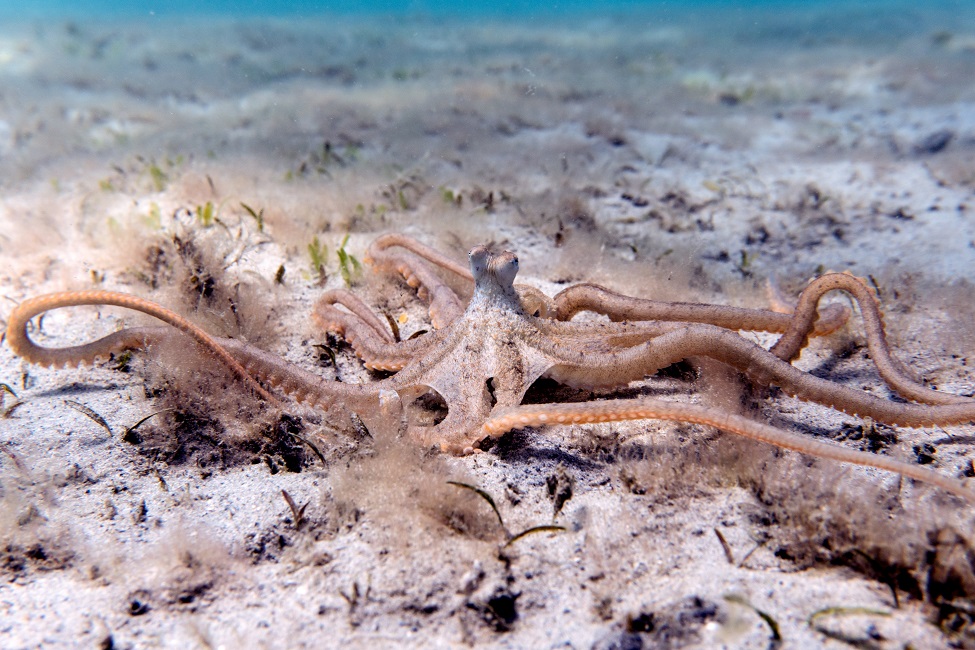‘Octo Girl’ Takes a Deep Dive to Uncover How Octopus Species Coexist

Macrotritopus defilippi (Atlantic longarm octopus) (Photo credit: Chelsea O. Bennice, Ph.D.)
There are more than 300 species of octopus living in diverse habitats that span coral reefs, seagrass beds, sand plains and polar ice regions where they feed on lower trophic levels. Most famous for having eight arms (octopus comes from the Greek, octópus, which means “eight foot”), the behavioral ecology of these mysterious sea creatures, especially octopuses that share habitats, is important for understanding the role they play in community structure and biodiversity of an ecosystem. Coexistence has been well studied in many species, but seldom in cephalopods like octopuses.
Researchers from Florida Atlantic University in collaboration with the Marine Biological Laboratory in Woods Hole, conducted the first in situ, long-term (three years, 371 SCUBA dive hours) study in a South Florida lagoon on two species of octopus. The aim of the study was to explore how Octopus vulgaris (common octopus), a medium-sized octopus that is widely distributed in tropical and temperate seas worldwide and Macrotritopus defilippi (Atlantic longarm octopus), a small species of octopus found in the Atlantic Ocean, Mediterranean Sea and in the Caribbean, coexist by examining their foraging habits and tactics, diet, behaviors and when they are active or inactive.
Rigorous fieldwork from the study included direct observations via SCUBA diving combined with active and remote video recordings. What the researchers discovered, published in the Journal of Experimental Marine Biology and Ecology , is that very different behaviors and habits in these two species of octopus is exactly how these species coexist in a shallow Florida lagoon- even at high densities.
Previously, the research team discovered that there is fine-scale habitat partitioning between these species, but they still inhabit the same general areas and could be utilizing multiple resource partitioning mechanisms at varying degrees. The diet, activity periods, and foraging strategies of the common octopus have not been studied at this South Florida lagoon and have never been studied in the presence of the Atlantic longarm octopus. For the Atlantic longarm octopus, there are no reports on diet or foraging strategies and only two reports on activity period, which are conflicting.
“Incorporating species-specific behavioral habits is a key tool for understanding octopus ecology and coexistence,” said Chelsea O. Bennice, Ph.D., (aka “Octo Girl”) first author, an affiliate assistant scientist, Department of Biological Sciences, FAU Charles E. Schmidt College of Science; and assistant director, FAU’s ASCEND programs to Advance STEM-Community Engagement through Neuroscience Discovery, within the Stiles-Nicholson Brain Institute on the John D. MacArthur Campus at Jupiter.
Along with foraging behaviors, Bennice and co-authors W. Randy Brooks, Ph.D., FAU Department of Biological Sciences; and Roger T. Hanlon, Ph.D., Marine Biological Laboratory, chose to examine diet and activity periods for each species as potential resource partitioning mechanisms because they are the primary niche dimensions, usually partitioned between species along with habitat, which they previously examined.
Results showed that the common octopus was primarily nocturnal (active at night), foraged on hard bottom substrate, and consumed mostly bivalves such as oysters, clams and scallops, while the Atlantic longarm octopus was strictly diurnal (active during the day), foraged on soft bottom substrate, and exclusively consumed crustaceans such as crabs and shrimps.
Both species showed a saltatory (stop and go) foraging tactic dominated by speculative bottom searching, which is a behavior guided by visual scanning and decision making, followed by tactile endeavors of the arms and chemotactile suckers. Species-specific behaviors were parachute attack (common octopus), mimicry of flounder swimming (Atlantic longarm octopus), and tripod stance (Atlantic longarm octopus).
“We found clear differences in substrates and prey types as well as activity periods. Given that each species also hides in a different manner – the common octopus in shells or hard substrate dens, and the Atlantic longarm octopus in holes and burrows in the sand – collectively, we now understand how these two species can coexist even at relatively high densities,” said Bennice. “Additional behavioral ecology studies can help us better understand environmental requirements needed for cephalopods, an important group in many marine food webs.”
Funding sources for this project included the Broward Shell Club, the Palm Beach Fishing Club, and the Animal Behavior Society. The Sholley Foundation provided partial funding for this research awarded to Hanlon.
Chelsea O. Bennice, Ph.D., (aka “Octo Girl”) and collaborators observed how diverse species of octopus coexist by using active and remote video
-FAU-
Tags: jupiter | science | research | faculty and staff